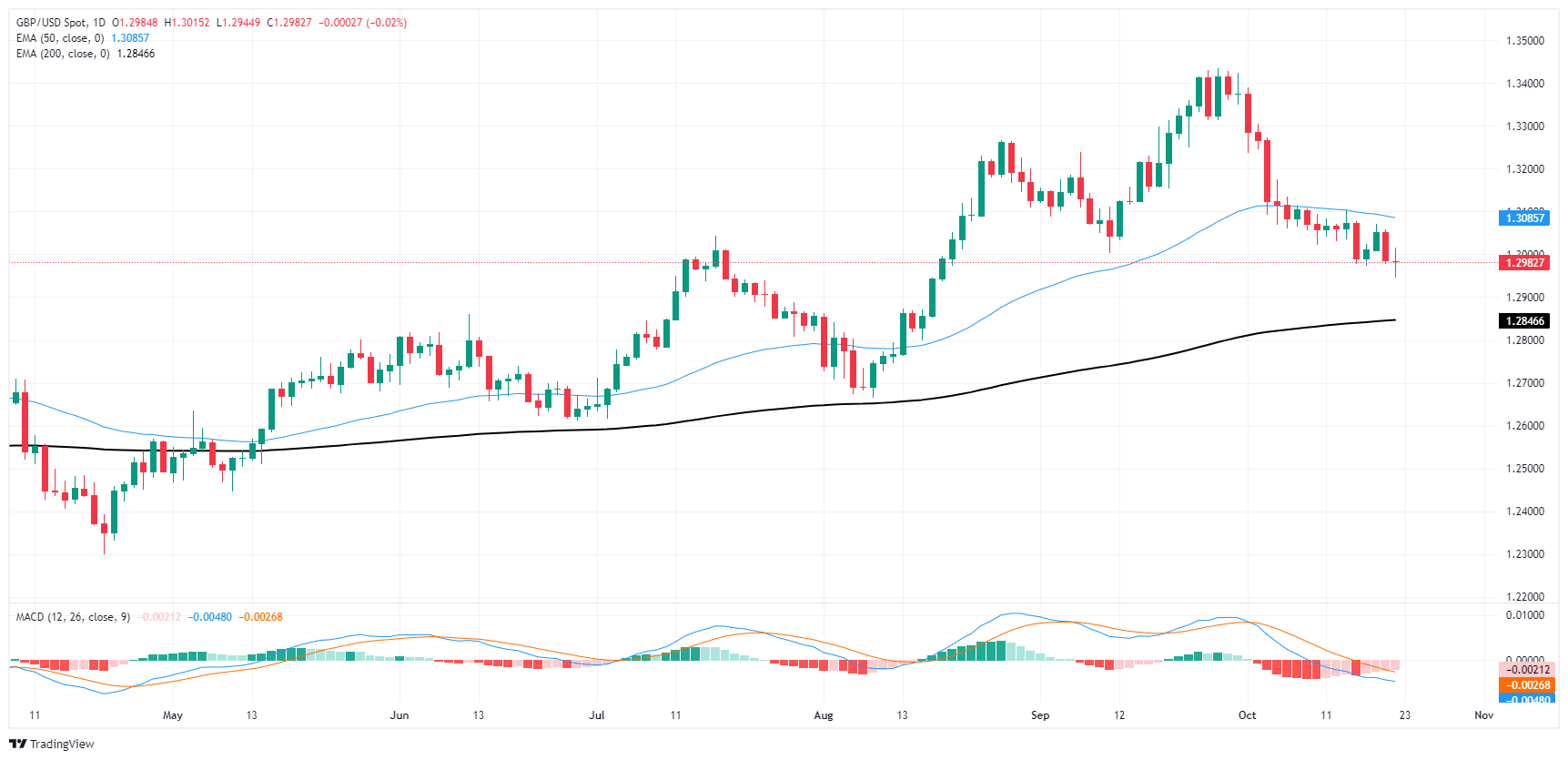GBP/USD skids to a halt with plenty of central bank talk in the barrel
|
- GBP/USD scratched momentum on Tuesday, holding flat near 1.3000.
- BoE Governor Bailey made his first of four public outings on Tuesday.
- UK and US PMI figures due on Thursday.
GBP/USD held steady on Tuesday, testing the waters near the 1.3000 handle. Intraday price action tested a fresh nine-week low, and topside bidding failed to make a mark above 1.3000, keeping near-term momentum hobbled in a midrange just below the key handle.
Bank of England (BoE) Governor Andrew Bailey made his first of four appearances on the docket this week. BoE’s Bailey mostly stuck to the middle of recent scripts, though the BoE head did note some regret at the BoE’s complacency regarding recent financial stability risks.
With three more BoE Bailey appearances this week, Cable traders will keep track of any repetitious statements on Governor Bailey’s speech cards. BoE head Bailey has an appearance on the cards late Wednesday, then Pounsd traders will be pivoting to UK Purchasing Managers Index (PMI) figures coming up on Thursday.
Median market forecasts are expecting a slight downtick in UK activity numbers, with October’s Services PMI specifically expected to ease to 52.2 from 52.4 the previous month.
GBP/USD price forecast
The GBP/USD pair is facing increased selling pressure as it slips below the key psychological level of 1.3000. The pair is currently trading near 1.2980, hovering just above the 200-day exponential moving average (EMA) at 1.2846, which acts as a critical support zone. The 50-day EMA at 1.3085 is sloping downward, indicating that the near-term trend remains bearish. The downward momentum from the September highs near 1.3650 highlights a weakening of bullish strength, with lower highs and lower lows forming since mid-September, suggesting that bears are currently in control.
The MACD indicator paints a bearish picture as well, with the MACD line well below the signal line and the histogram extending deeper into negative territory. This signals further downside risk for the pair, especially if it breaks below the 200-day EMA. A decisive close below 1.2850 could accelerate the selling pressure, with the next support level emerging around 1.2750. On the flip side, a recovery above the 50-day EMA near 1.3085 would be needed to shift the sentiment back in favor of the bulls, though this appears unlikely in the short term given current technical conditions.
GBP/USD daily chart

Pound Sterling FAQs
The Pound Sterling (GBP) is the oldest currency in the world (886 AD) and the official currency of the United Kingdom. It is the fourth most traded unit for foreign exchange (FX) in the world, accounting for 12% of all transactions, averaging $630 billion a day, according to 2022 data. Its key trading pairs are GBP/USD, also known as ‘Cable’, which accounts for 11% of FX, GBP/JPY, or the ‘Dragon’ as it is known by traders (3%), and EUR/GBP (2%). The Pound Sterling is issued by the Bank of England (BoE).
The single most important factor influencing the value of the Pound Sterling is monetary policy decided by the Bank of England. The BoE bases its decisions on whether it has achieved its primary goal of “price stability” – a steady inflation rate of around 2%. Its primary tool for achieving this is the adjustment of interest rates. When inflation is too high, the BoE will try to rein it in by raising interest rates, making it more expensive for people and businesses to access credit. This is generally positive for GBP, as higher interest rates make the UK a more attractive place for global investors to park their money. When inflation falls too low it is a sign economic growth is slowing. In this scenario, the BoE will consider lowering interest rates to cheapen credit so businesses will borrow more to invest in growth-generating projects.
Data releases gauge the health of the economy and can impact the value of the Pound Sterling. Indicators such as GDP, Manufacturing and Services PMIs, and employment can all influence the direction of the GBP. A strong economy is good for Sterling. Not only does it attract more foreign investment but it may encourage the BoE to put up interest rates, which will directly strengthen GBP. Otherwise, if economic data is weak, the Pound Sterling is likely to fall.
Another significant data release for the Pound Sterling is the Trade Balance. This indicator measures the difference between what a country earns from its exports and what it spends on imports over a given period. If a country produces highly sought-after exports, its currency will benefit purely from the extra demand created from foreign buyers seeking to purchase these goods. Therefore, a positive net Trade Balance strengthens a currency and vice versa for a negative balance.
Information on these pages contains forward-looking statements that involve risks and uncertainties. Markets and instruments profiled on this page are for informational purposes only and should not in any way come across as a recommendation to buy or sell in these assets. You should do your own thorough research before making any investment decisions. FXStreet does not in any way guarantee that this information is free from mistakes, errors, or material misstatements. It also does not guarantee that this information is of a timely nature. Investing in Open Markets involves a great deal of risk, including the loss of all or a portion of your investment, as well as emotional distress. All risks, losses and costs associated with investing, including total loss of principal, are your responsibility. The views and opinions expressed in this article are those of the authors and do not necessarily reflect the official policy or position of FXStreet nor its advertisers.